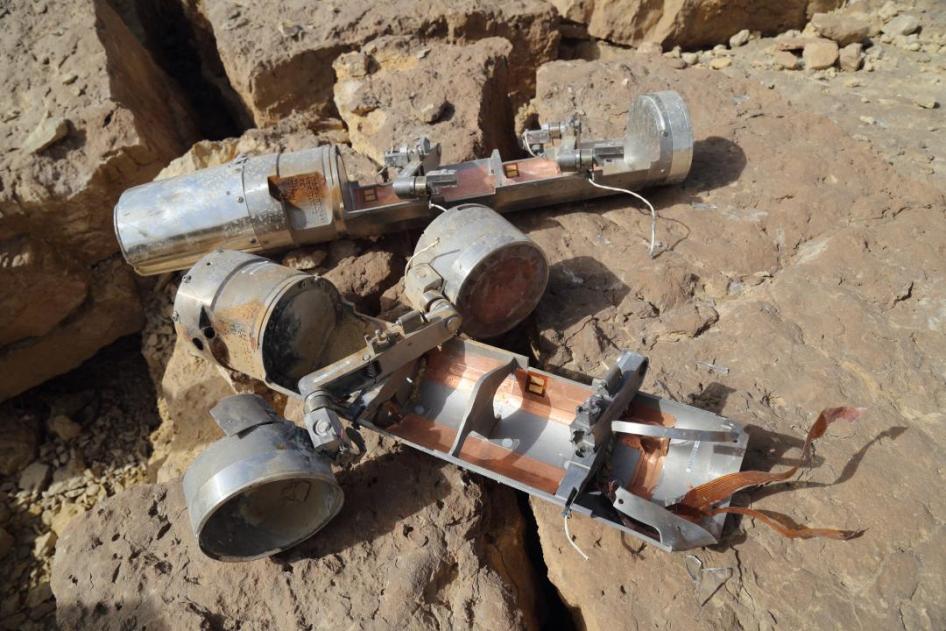You can always tell a policy development is significant when it’s released late Friday afternoon – and before a holiday weekend to boot. The decision by the United States to “hold” further transfers of CBU-105 cluster munitions to Saudi Arabia is a perfect example. In this case it was even more obscure than usual since the information was leaked rather than announced by news release.
It shows the Obama administration isn’t impervious to the rising chorus of criticism against its generous backing of Saudi Arabia’s military operation in Yemen. That refrain has only gotten louder as civilian casualties have mounted in the thousands and the country’s infrastructure and economy have been decimated.
It shows how the 2008 treaty banning cluster munitions signed by 119 countries is having an impact as states that haven’t joined begin to adjust their attitudes toward these weapons. Cluster munitions spread thousands of submunitions, or bomblets, over a wide area. The unexploded bomblets from cluster munitions effectively become landmines that threaten every man, woman, and child in the area until and unless they are cleaned up.
The use of CBU-105 Sensor Fuzed Weapons and other banned cluster munitions for the past year in Yemen by a Saudi Arabia-led coalition of states has ignited a firestorm of concern. In tackling cluster munition transfers, the White House has touched on sensitive aspects of US policy that remain out-of-line with the emerging international norm against the weapons.
If we rewind to 2007-2008, the United States sat out the Oslo Process to negotiate an international treaty banning cluster munitions in protest. It objected to the unconventional diplomatic process led by Norway outside the hallowed halls of the United Nations (UN). And, having produced, transferred, and used cluster munitions extensively, the US clearly saw military utility in these weapons.
So the US expressed its concerns about the treaty through the back door, via allies participating in the negotiations such as Canada, Japan, and the United Kingdom. Two weeks after the treaty was adopted by more than 100 nations in Dublin on May 30, 2008, the Bush administration agreed to a little-noticed Pentagon policy directive on the weapons. The policy commits the US to not produce, transfer, or use cluster munitions after 2018 that leave more than 1 percent unexploded ordnance.
Implementation of this policy is believed to be on track, despite a lack of information from the Department of Defense on the process. The implications are significant as 99 percent of existing US stocks do not meet the 1 UXO percent requirement and must be destroyed. By February 2015, the Pentagon had removed approximately 221,502 tons of cluster munitions from active stocks and placed them in the demilitarization account for eventual destruction, while an additional 250,224 tons will be added by the 2018 policy deadline.
The US last budgeted funds to produce new cluster munitions for its own stockpiles in 2007. It still permits transfers of these weapons under export law regulations dating to December 2007 that are conditional on two requirements. In addition to the requirement that after arming, the submunitions must not fail and create unexploded ordnance (UXO) more than one percent of the time, the recipient must uphold restrictions on how they are used. Specifically, these weapons must not be used in civilian areas and only against clearly defined military targets.
Since 2008, the CBU-105 Sensor Fuzed Weapon manufactured by Textron Systems has been the only type of cluster munition exported by the US, as the Pentagon determined that it meets this standard. The weapon is prohibited by the 2008 Convention on Cluster Munitions but the US hasn’t joined – nor have Saudi Arabia or other countries that have received these weapons.
Since 2008, Congressional notifications show how the US has exported CBU-105 Sensor Fuzed Weapons to India, Saudi Arabia South Korea, United Arab Emirates, and Taiwan.
Saudi Arabia is the first of these recipients to admit to using them. The first evidence came just two weeks after the air campaign in Yemen began at the end of March 2015. Photographs and video of the weapons taken by locals in Yemen circulated swiftly on social media. The locations of attack were identified and combined with satellite imagery analysis.
Over the past year Human Rights Watch researchers conducted four research missions to Yemen and found evidence of at least five attacks involving the use of CBU-105 Sensor Fuzed Weapons in four governorates, while Amnesty International recorded a June 2015 attack involving the CBU-105. The evidence has been published in several reports that have attracted strong media coverage, provoking public outcry and widespread condemnation.
Many have contributed to increasing the drumbeat of alarm at the use of cluster munitions in Yemen over the past year, and especially in recent weeks. Congressional supporters of barring the export of these weapons —both Democrat and Republican—embarked on several legislative initiatives after MoveOn petitioned them to stop cluster munition transfers to Saudi Arabia.
Local activists held multiple demonstrations outside Textron’s corporate headquarters in Rhode Island -- three were arrested. The US non-governmental organizations that make up the Cluster Munition Coalition-US have engaged with diplomats and other officials to seek an end to the cluster munitions transfers in light of the civilian casualties. Reporters from national and regional media outlets have kept up a steady stream of inquiries to White House, State Department, and Defense Department officials.
One lesson from the US suspension of cluster munition transfers to Saudi Arabia is the futility of technical fixes favored by the United States in its pursuit of ever-improved weapons. The CBU-105 is the only type of cluster munition exported by the US since 2008 because it supposedly solved the kinds of failures rife among its predecessors, which will all be completely prohibited by the US in less than two years.
Our researchers found multiple examples of CBU-105 Sensor Fuzed Weapons not functioning in ways that meet the required one percent reliability standard. They documented canisters from the weapons with all four “skeet” or submunitions still attached. Or with two attached.
They found individual “skeet” or submunitions that were still intact, containing explosives. During a visit to investigate an attack on a remote village, a boy of about 10 came rushing out when he heard the researchers were there, and tried to hand them an unexploded “skeet.”
Textron’s chief executive officer argues that these remnants demonstrate that the weapons functioned “exactly as designed and with no threat to civilians” because “a munition did not locate a target vehicle while in the air, and then disarmed itself on the ground.”
But a dud must still be considered hazardous regardless of the technical fix. US government officials involved in funding clearance and destruction of landmines and explosive remnants of war acknowledge that any unexploded ordnance should be “treated appropriately.” That means they should not be handled or approached by anyone other than a trained technician. Even the Pentagon’s own policy states, “self-deactivated submunitions will still be considered UXO.”
Three Yemeni deminers died in the course of duty last month and those left can’t keep up with the new contamination requiring clearance. This leaves locals with only one “safe” option: leave the remnants in place until help comes. Civilians have no way to evaluate the status of failed submunitions from the CBU-105.
Countries not wanting to be stigmatized will often deny using banned weapons or argue they are not covered by the prohibition. Saudi Arabia has repeatedly denied using the six other types of cluster munitions that have been documented in Yemen. It has asserted that CBU-105 are not banned cluster munitions as its manufacturer Textron also argues.
But the Pentagon describes the CBU-105 Sensor Fuzed Weapon as a cluster munition even though it had not treated it as “banned.” Saudi Arabia’s coalition partner the United Arab Emirates, acknowledges it has received CBU-105 in the past but emphatically denies using them in Yemen because they are banned by the Convention on Cluster Munitions
Instead of making excuses, the US now has taken a principled route in response to the criticisms raised about civilian victims of the US cluster munitions used by the Saudi-led coalition. The US acknowledged concerns of civilian harm and suspended future cluster munition transfers to Saudi Arabia.
This shows how global perception of these weapons has shifted, even among nations that remain outside the international treaty to ban the weapons.
Under the Obama administration, US officials have made statements and supported resolutions expressing concern and/or condemning recent use of cluster munitions, for example in Syria and Ukraine. The US has only used cluster munitions once since the 2003 invasion of Iraq—in a 2009 attack by cruise missiles equipped with submunitions in Yemen.
The CBU-105 is the last barrier left in the way of US accession to the Convention on Cluster Munitions.
The US remains the largest contributor to mine and explosive remnants of war clearance programs around the world. The decision to stop transfers shows how any cluster munition use is incompatible with its growing moral obligation to help deal with the unexploded ordnance left by its weapons in conflicts around the world.
Does the US still view the military utility of cluster munitions as outweighing the harm caused to civilian populations? In listening to humanitarian concerns, the Obama administration has taken a tentative step in the right direction.









